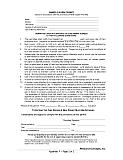Appendix F - Community Guidelines
Sample Burn Permit
Download the Sample Burn Permit fact sheet for Lincoln County

(PDF, 34kb, 1 page)
Fire Safe Community Recommendations for Planning New Developments
Sample Building Department Requirements
- A complete fire flow water system capable of meeting the residential calculated fire flow requirements as prescribed by the Uniform Fire Code Appendix III-A shall be installed.
- All fire hydrant locations shall be reviewed and approved by the county building department and shall be in proximity to streets so that snow accumulation at the hydrants may be removed during routing snow plowing operations.
- All roadways within the project shall meet requirements of paved all-weather surface, Uniform Fire Code Article 9, Section 901 and 902 conditions, and shall be designated no parking zones where roads are less than 24 feet wide. If steep roads prevent constructing 24-foot wide roads, then turnouts must be installed every 1/4 mile. Homes with long private drives must have a turn around (50-foot radius), or a horseshoe drive or a hammerhead drive that allows large engines to turn around. Cul-de-sacs shall have a minimum 50-foot radius.
- There shall be a minimum of two-ways in and two-ways out of the development. These shall be completed prior to the delivery of any combustible materials to the project site.
- A fuels management/reduction program around all structures shall be maintained a minimum 30 feet in accordance with Uniform Fire Code Appendix 11-A-16.
- Clearance of vegetative growth from roadways must be performed in accordance with Uniform Fire Code Appendix II-A-17.
- Developers should submit a fuels modification plan for the entire acreage. A property line 20-foot minimum fuelbreak shall be completed prior to approval of any final map.
- All new structures shall be constructed with fire retardant roofing materials in compliance with Nevada Revised Statute 472.100.
These recommendations are provided as a guideline to fire safe community development and are not intended to supersede existing fire codes.
